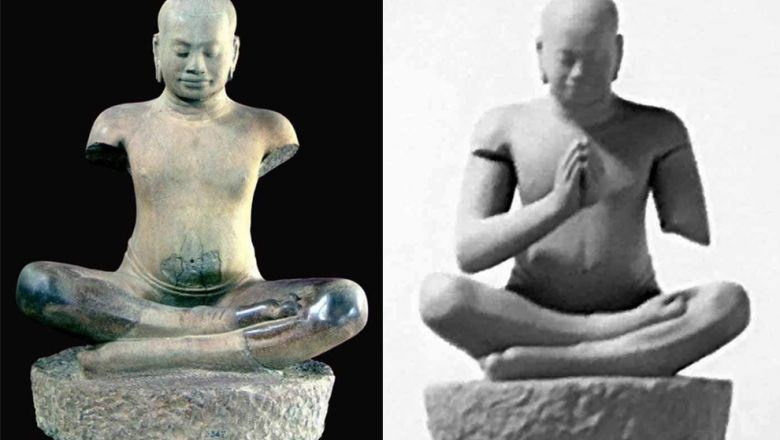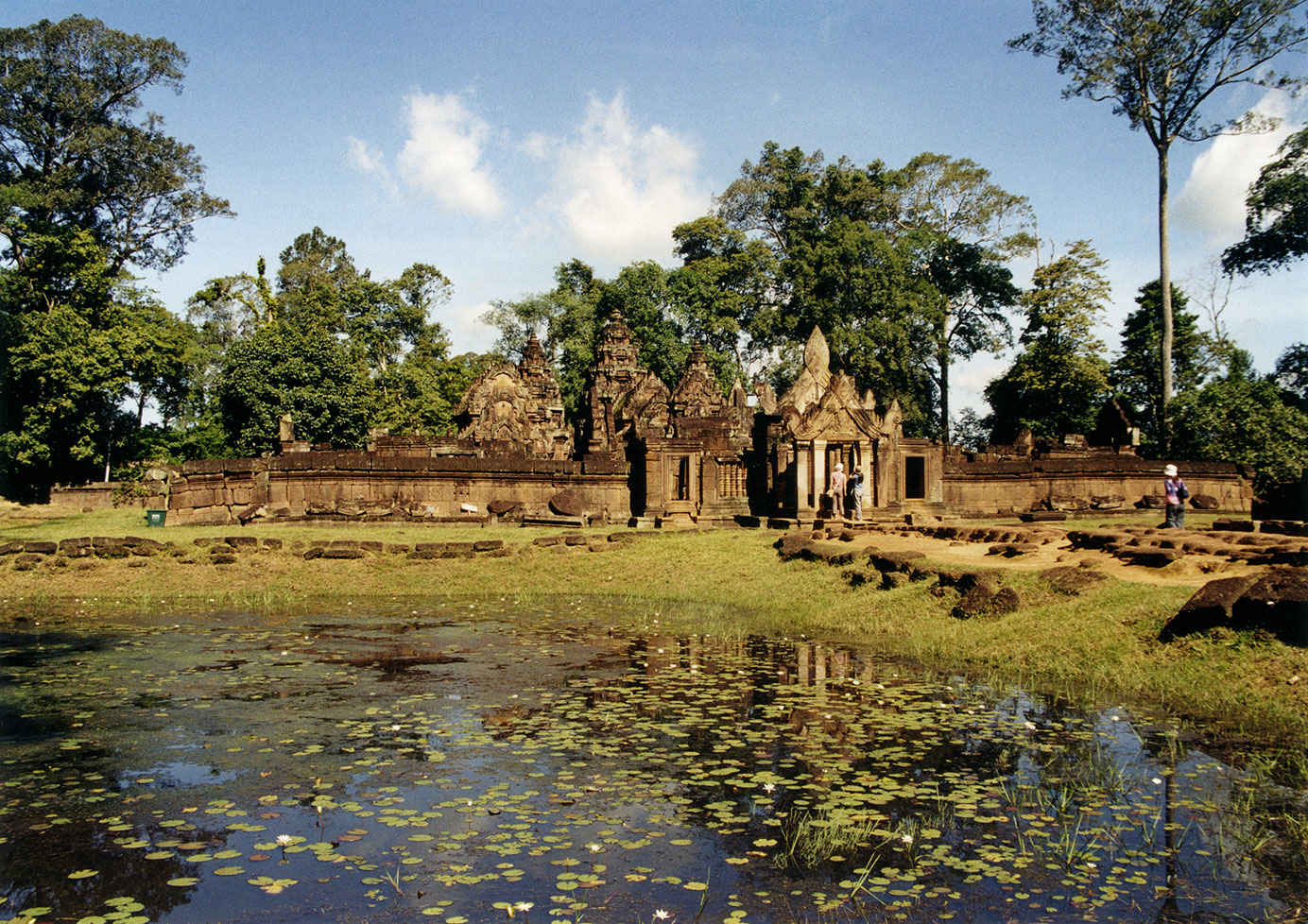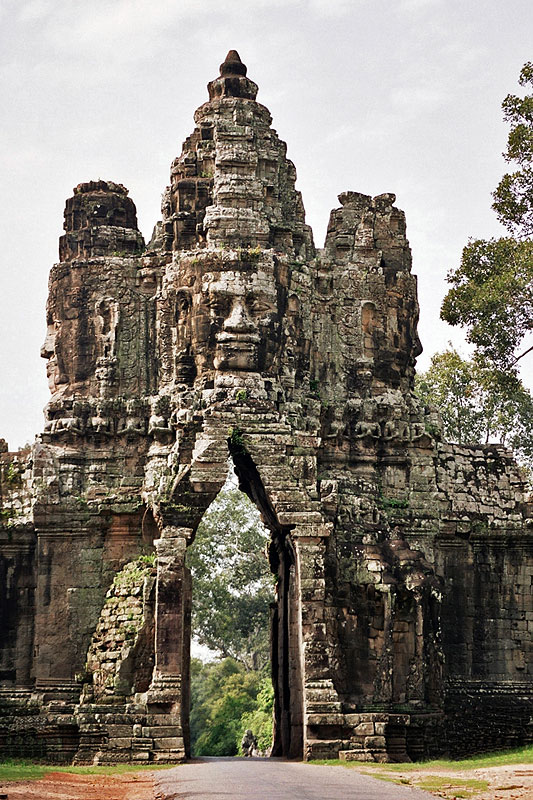|
Yaśodharapura
Yashodharapura (; ;Headley, Robert K.; Chim, Rath; Soeum, Ok. 1997. ''Cambodian-English Dictionary''. Dunwoody Press. University of Michigan. . http://sealang.net/khmer/dictionary.htm ''"Yashodharapura"''), also known as Angkor (), was the capital of the Khmer Empire for most of its history. It was established by King Yashovarman I in the late 9th century and centred on the temple of Phnom Bakheng.Higham, C., 2001, The Civilization of Angkor, London: Weidenfeld & Nicolson, Yashodharapura was referred to in the inscriptions as Phnom Kandal (Central Mountain). Phnom Bakheng was constructed just before the foundation of Yashodharapura due to Yashovarman's belief that the mountain was among the holiest of places to worship the Hindu deities. Yashodharapura was linked to an earlier capital, Hariharalaya, by a causeway. The urban complex included the East Baray or Yashodharatataka. The succeeding capitals built in the area were called Yashodharapura. One of those is Angkor Thom, c ... [...More Info...] [...Related Items...] OR: [Wikipedia] [Google] [Baidu] |
Hariharalaya
Hariharalaya (, Hariharalaya) was an ancient city and capital of the Khmer Empire, Khmer empire located near Siem Reap, Cambodia in an area now called Roluos (temples), Roluos (Khmer language, Khmer: រលួស). Today, all that remains of the city are the ruins of several royal temples: Preah Ko, the Bakong, Lolei.Higham, C., 2001, The Civilization of Angkor, London: Weidenfeld & Nicolson, Higham, C., 2014, Early Mainland Southeast Asia, Bangkok: River Books Co., Ltd., Etymology The name "Hariharalaya" is derived from the name of Harihara, a Hinduism, Hindu god prominent in pre-Khmer Empire, Angkorian Cambodia. The name "Harihara" in turn is a composite of "Hari" (a name of the Hindu god Vishnu) and "Hara" (a name of the Hindu god Shiva). Cambodian representations of Harihara were of a male god whose one side bore the attributes of Vishnu and whose other side bore the attributes of Shiva. For example, the god's head-covering consisted of a mitre-type hat (the attribute of ... [...More Info...] [...Related Items...] OR: [Wikipedia] [Google] [Baidu] |
Angkor Wat
Angkor Wat (; , "City/Capital of Wat, Temples") is a Buddhism and Hinduism, Hindu-Buddhist temple complex in Cambodia. Located on a site measuring within the ancient Khmer Empire, Khmer capital city of Angkor, it was originally constructed in 1150 CE as a Hindu temple dedicated to the deity Vishnu. It was later gradually transformed into a Buddhist temple towards the end of the century. Considered by some experts to be the List of largest Hindu temples, largest religious structure in the world, it is regarded as one of the best examples of Khmer architecture and a symbol of Cambodia, depicted as a part of the Flag of Cambodia, Cambodian national flag. Angkor Wat was built at the behest of the Khmer king Suryavarman II in the early 12th century in Yaśodharapura (present-day Angkor), the capital of the Khmer Empire, as his state temple and eventual mausoleum. Angkor Wat combines two basic plans of Khmer temple architecture: the Khmer architecture#Temple mountain, temple-moun ... [...More Info...] [...Related Items...] OR: [Wikipedia] [Google] [Baidu] |
Jayavarman VII
Jayavarman VII (), known posthumously as Mahaparamasaugata (, c. 1122–1218), was king of the Khmer Empire. He was the son of King Dharanindravarman II (r. 1150–1160) and Queen Sri Jayarajacudamani. He was the first king devoted to Buddhism, as only one prior Khmer king had been a Buddhist. He then built the Bayon as a monument to Buddhism. Jayavarman VII is generally considered the most powerful of the Khmer monarchs by historians. His government built many projects including hospitals, highways, rest houses, and temples. With Buddhism as his motivation, King Jayavarman VII is credited with introducing a welfare state that served the physical and spiritual needs of the Khmer people. Defeat of the Cham and coronation In 1177 and again in 1178, the Champa, Cham invaded the Khmer Empire. In 1177, Champa King Jaya Indravarman IV launched a surprise attack on the Khmer capital by sailing a fleet up the Mekong River, across Lake Tonlé Sap, and then up the Siem Reap River, a t ... [...More Info...] [...Related Items...] OR: [Wikipedia] [Google] [Baidu] |
Yasovarman I
Yasovarman I () was an Angkorian king who reigned in 889–910 CE. He was called " Leper King". Early years Yasovarman was a son of King Indravarman I and his wife Indradevi. Yasovarman was said to be a wrestler. Inscriptions say he was capable of wrestling with elephants. The inscriptions also say he was capable of slaying tigers with his bare hands. His teacher was the ''purohit'' Brahman Vamasiva, part of the Devaraja cult priesthood. Vamasiva's guru, Sivasoma, was connected to the Hindu philosopher Adi Shankara. After the death of Indravarman, a succession war was fought by his two sons, Yasovarman and his brother, a case of sibling rivalry. It is believed that the war was fought on land and on sea by the Tonlé Sap. In the end Yasovarman prevailed. Because of his father had sought to deny his accession, according to inscriptions cited by L.P. Briggs, "Yasovarman I ignored his claim to the throne through his father, Indravarman I, or through Jayavarman II, the founder ... [...More Info...] [...Related Items...] OR: [Wikipedia] [Google] [Baidu] |
Banteay Srei
Banteay Srei ( ) is a 10th century CE Cambodian temple dedicated to the Hindus, Hindu gods Shiva and Parvati. Located in the area of Angkor, it lies near the hill of Phnom Dei, north-east of the main group of temples that once belonged to the medieval capitals of Yaśodharapura and Angkor Thom.Higham, ''The Civilization of Angkor'', p.79. Banteay Srei is built largely of red sandstone, a medium that lends itself to the elaborate decorative wall carvings which are still observable today. The buildings themselves are miniature in scale, unusually so when measured by the standards of Angkorian construction. These factors have made the temple extremely popular with tourists, and have led to its being widely praised as the jewel of Khmer art. History Foundation and dedication Consecrated on 22 April 967 CE, Banteay Srei was the only major temple at Angkor not built by rulers; its construction is credited to the courtiers named Vishnukumara and YajnavarahaHigham, C., 2014, Early Mai ... [...More Info...] [...Related Items...] OR: [Wikipedia] [Google] [Baidu] |
Khmer Empire
The Khmer Empire was an empire in Southeast Asia, centered on Hydraulic empire, hydraulic cities in what is now northern Cambodia. Known as Kambuja (; ) by its inhabitants, it grew out of the former civilization of Chenla and lasted from 802 to 1431. Historians call this period of History of Cambodia, Cambodian history the Angkor period, after the empire's most well-known capital, Angkor. The Khmer Empire ruled or vassalised most of Mainland Southeast Asia and stretched as far north as southern China. The beginning of the Khmer Empire is conventionally dated to 802, when Khmer people, Khmer prince Jayavarman II declared himself ''chakravartin'' (, a title equivalent to 'emperor') in the Phnom Kulen mountains. Although the end of the Khmer Empire has traditionally been marked with the fall of Angkor to the Siamese Ayutthaya Kingdom in 1431, the reasons for the empire's collapse are still debated amongst scholars. Researchers have determined that a period of strong monsoon rains ... [...More Info...] [...Related Items...] OR: [Wikipedia] [Google] [Baidu] |
Angkor
Angkor ( , 'capital city'), also known as Yasodharapura (; ),Headly, Robert K.; Chhor, Kylin; Lim, Lam Kheng; Kheang, Lim Hak; Chun, Chen. 1977. ''Cambodian-English Dictionary''. Bureau of Special Research in Modern Languages. The Catholic University of America Press. Washington, D.C. Chuon Nath Khmer Dictionary (1966, Buddhist Institute, Phnom Penh). was the capital city of the Khmer Empire, located in present-day Cambodia. The city and empire flourished from approximately the 9th to the 15th centuries. The city houses the Angkor Wat, one of Cambodia's most popular tourist attractions. The name ''Angkor'' is derived from ''nokor'' (), a Khmer language, Khmer word meaning "kingdom" which in turn derived from Sanskrit ''nagara'' (), meaning "city". The Angkorian period began in AD 802, when the Khmer people, Khmer Hinduism, Hindu monarch Jayavarman II declared himself a "universal monarch" and "Devaraja, god-king", and lasted until the late 14th century, first falling under Ayut ... [...More Info...] [...Related Items...] OR: [Wikipedia] [Google] [Baidu] |
Hindu
Hindus (; ; also known as Sanātanīs) are people who religiously adhere to Hinduism, also known by its endonym Sanātana Dharma. Jeffery D. Long (2007), A Vision for Hinduism, IB Tauris, , pp. 35–37 Historically, the term has also been used as a geographical, cultural, and later religious identifier for people living in the Indian subcontinent. It is assumed that the term ''"Hindu"'' traces back to Avestan scripture Vendidad which refers to land of seven rivers as Hapta Hendu which itself is a cognate to Sanskrit term ''Sapta Sindhuḥ''. (The term ''Sapta Sindhuḥ'' is mentioned in Rig Veda and refers to a North western Indian region of seven rivers and to India as a whole.) The Greek cognates of the same terms are "''Indus''" (for the river) and "''India''" (for the land of the river). Likewise the Hebrew cognate ''hōd-dū'' refers to India mentioned in Hebrew BibleEsther 1:1. The term "''Hindu''" also implied a geographic, ethnic or cultural identifier for ... [...More Info...] [...Related Items...] OR: [Wikipedia] [Google] [Baidu] |
Borommarachathirat II
Borommarachathirat II or Borom Rachathirat II (), also known as King Samphraya () (1386–1448), was a king of Ayutthaya. His reign saw its early expansions. He was a son of Intharacha who had finally taken the Ayutthayan throne for the Suphannaphum Dynasty. He had two elder brothers: Prince Aiphraya and Prince Yiphraya; and was appointed by his father to govern Chainat ( Phitsanulok's old name). In 1424, Intharacha died. His two brothers marched from their respective cities to Ayutthaya for the throne. They fought on elephants in single combat and both died, leaving the throne to Samphraya. In 1433 Samphraya led Siamese forces to subjugate Cambodia plundering Angkor Thom. This assault eventually caused the Khmers to abandon Angkor and to relocate their capital further south-east.Chakrabongse, C., 1960, Lords of Life, London: Alvin Redman Limited And he ordered the Nakhonin to rule in Cambodia. Later, the Nakhonin died, he appointed the Prince of Phrak, his another son to ... [...More Info...] [...Related Items...] OR: [Wikipedia] [Google] [Baidu] |
Ayutthaya Kingdom
The Ayutthaya Kingdom or the Empire of Ayutthaya was a Thai people, Thai kingdom that existed in Southeast Asia from 1351 to 1767, centered around the city of Phra Nakhon Si Ayutthaya (city), Ayutthaya, in Siam, or present-day Thailand. European travellers in the early 16th century called Ayutthaya one of the three great powers of Asia (alongside Vijayanagara Empire, Vijayanagara and China). The Ayutthaya Kingdom is considered to be the precursor of modern Thailand, and its developments are an important part of the history of Thailand. The name Ayutthaya originates from Ayodhya (Ramayana), Ayodhya, a Sanskrit word. This connection stems from the Ramakien, Thailand's national epic. The Ayutthaya Kingdom emerged from the Mandala (political model), mandala or merger of three maritime city-states on the Lower Chao Phraya Valley in the late 13th and 14th centuries (Lopburi province, Lopburi, Suphan Buri province, Suphanburi, and Ayutthaya). The early kingdom was a maritime confedera ... [...More Info...] [...Related Items...] OR: [Wikipedia] [Google] [Baidu] |
Uthong
King U-thongThe Royal Institute.'List of monarchs Ayutthaya''. (; ) or King Ramathibodi I (; ; , 1314–1369) was the first king of the kingdom Ayutthaya Kingdom, Ayutthaya (now part of Thailand), reigning from 1351 to 1369. Origins and Reign He was known as Prince U Thong (meaning "Golden Cradle") before he ascended to the throne in 1350. There are many theories about Uthong's background, including possibly being a descendant of Mangrai. According to a better-known source, a seventeenth-century account by Dutchman Jeremias van Vliet, a ''Renowned Legend'' stated that Ramatibodi was an ethnic Chinese, having sailed down from China. After succeeding in trade, he became influential enough to rule the city of Phetchaburi, (or Vajrapur in sanskrit ) a coastal town of the Gulf of Thailand, before travelling up to Ayutthaya Kingdom, Ayutthaya. Ramathibodi I established four Great Officers of State. These were the Ministry of Interior (Thailand), Ministry of the Interior (''Wieng'' ... [...More Info...] [...Related Items...] OR: [Wikipedia] [Google] [Baidu] |
Angkor Thom
Angkor Thom ( ; meaning "Great City"), alternatively Nokor Thom ( ), located in present-day Cambodia, was the last and most enduring capital city of the Khmer empire, Khmer Empire. It was established in the late twelfth century by King Jayavarman VII.Higham, C., 2014, Early Mainland Southeast Asia, Bangkok: River Books Co., Ltd., It covers an area of 9 km², within which are located several monuments from earlier eras as well as those established by Jayavarman and his successors. At the centre of the city is Jayavarman's state temple, the Bayon, with the other major sites clustered around the Victory Square immediately to the north. The site is one of the major tourist attractions of Southeast Asia. Etymology Angkor Thom () is the transform name from another alternative name of Nokor Thom (), which is believed to be the correct one, due to neglect of calling it in incorrect pronunciation. The word ''Nokor'' (, ) is literally derived from Sanskrit word of ''Nagara'' (Devanāgar ... [...More Info...] [...Related Items...] OR: [Wikipedia] [Google] [Baidu] |







